Tanghulu, Chinese candied fruit, is a street treat that became a hit quickly on TikTok. This easy-to-make sweet snack on a stick is juicy and crunchy which is a bit addicting. After one bite into a Tanghulu, you will want more of the fresh fruit and hardened sugar coating. It will crack open when you bite into it almost like it has a layer of edible sugar glass on the outside.
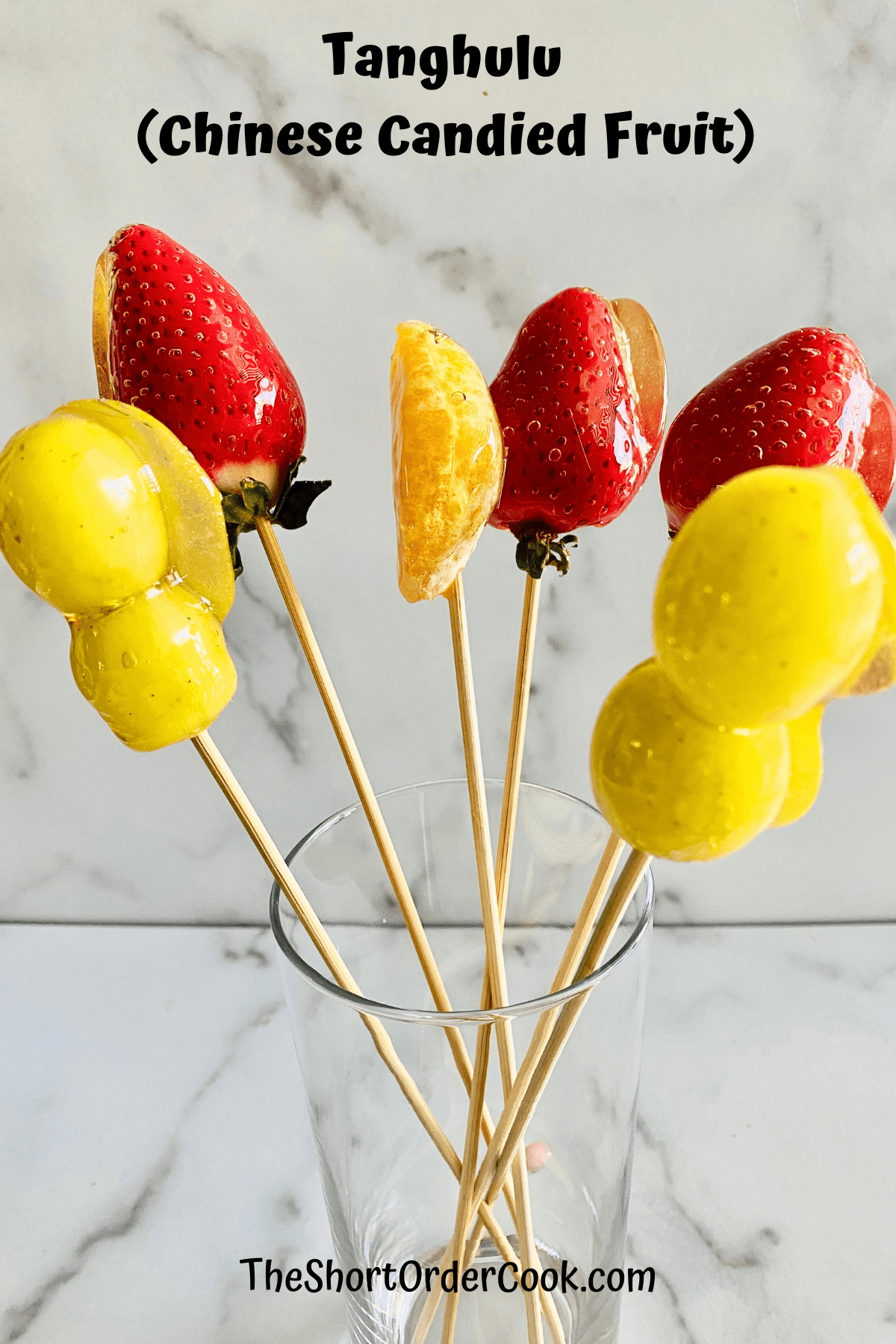
This easy recipe for candy-coated fruit skewers is fun to make and eat. This popular sugar fruit is made, served, & eaten off a long bamboo skewer. The fruit is not candied, the candy coating is what sweetens fresh strawberries, orange slices, & grapes in this recipe. This recipe may now be in a tie with FRESH STRAWBERRY MOUSSE PARFAITS, for our favorite berry dessert.
Jump to:
What is Tanghulu?
As mentioned, tanghulu is common street food in China. This sweet snack traditionally consists of dried hawthorn fruit that is rolled in melted sugar. These skewered tart crab apples are then cooled to have a hard candy shell. This recipe uses fruits that are more easily found and common in the United States but if you find dried hawthorn, please try it too.
Tanghulu may also be called Bingtang hulu. The origin of it goes back that far. With some reading about its history, tanghulu is believed to have been invented as far back as the Liao Dynasty. These sugar syrup-covered tart fruits are still enjoyed today.
Ingredients & Equipment
There are only 3 ingredients needed to make tanghulu. This recipe is made without corn syrup. The candy coating is a sugar and water syrup combination. This creates the delicious outer shell for these fruit treats on a stick.
Best Fruit for Tanghulu
The best fruits for making tanghulu are strawberries, grapes, and citrus fruits like oranges and mandarins. Other fruits to use to make the candied Chinese fruits included tart apple slices, firm melon chunks, firm kiwi, large blackberries, or pineapple chunks or spears. (pineapple is what I plan to try next!)
Pick your favorite fruits. The best fruits are ones that are large enough to stay on a skewer yet small enough to eat in 1-2 bites. Therefore, small berries are not a good option.
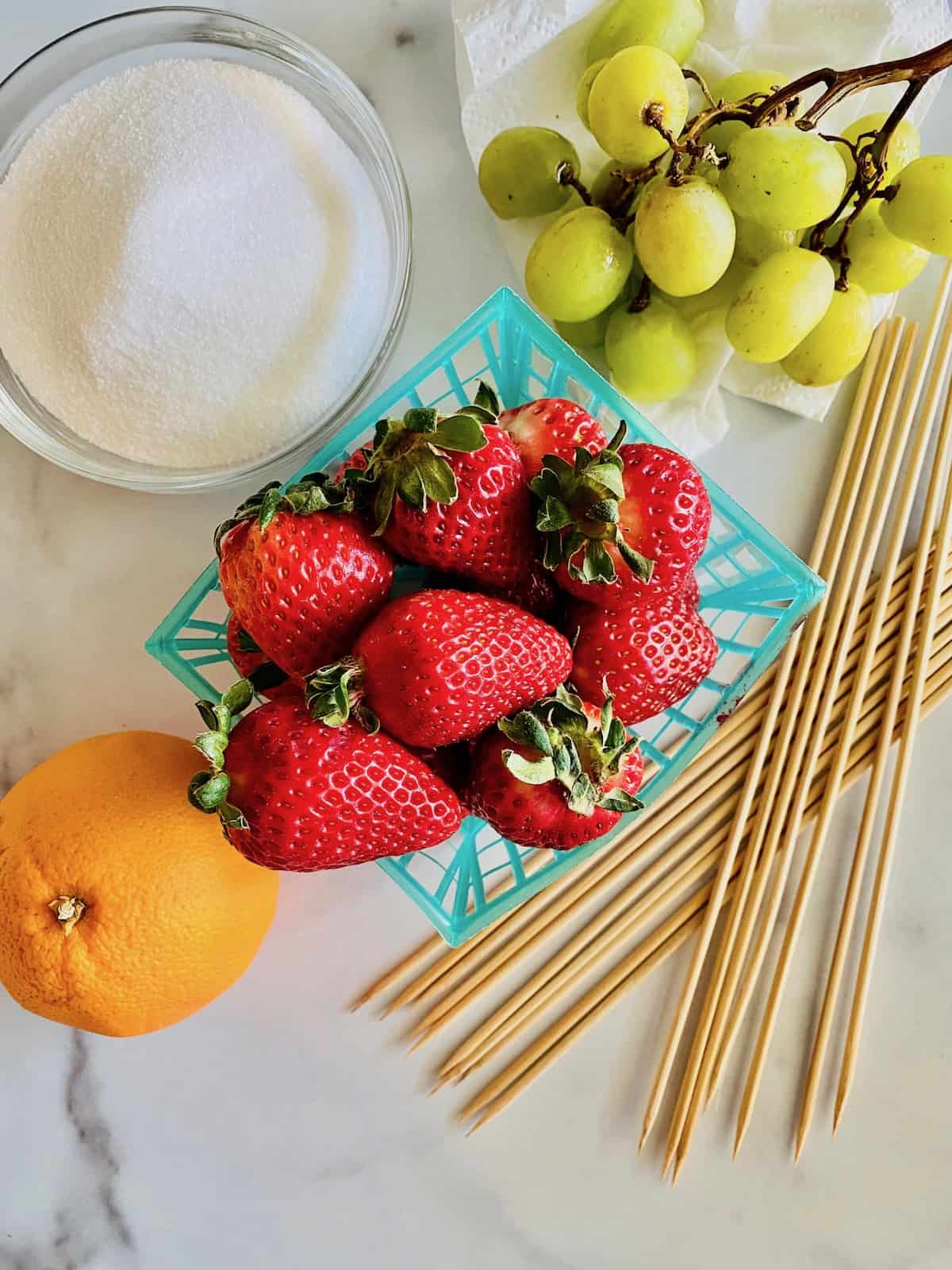
- Fresh strawberries
- Seedless grapes
- Orange
- Other fruits you enjoy ---
- Granulated Sugar
- Water
This recipe is easy to make if you have the right equipment. You will need parchment paper and a candy thermometer. You will also need bamboo skewers. They come in packs usually of 50 and that is ok. Save the leftovers to make my Teriyaki Chicken on a Stick recipe.
See the recipe card for quantities.
How to Make Tanghulu
Here are the easy steps for making Chinese candied fruits at home. Transform 3 ingredients in 3 quick steps for this recipe.
- Wash & Skewer the Fruit
- Make the Sugar Syrup
- Dip the Fruit
Wash & Skewer the Fruit
Begin by washing and thoroughly drying all the fruit pieces. Next, prep the fruit by pushing a bamboo skewer through each piece so the fruit is now on the very tip of the stick. I suggest one strawberry or orange segment per stick or 2 grapes per stick. Set aside.
Prep a large platter or baking sheet with parchment paper. You will need this to place the dipped fruit on to set (but not stick) for a few minutes.
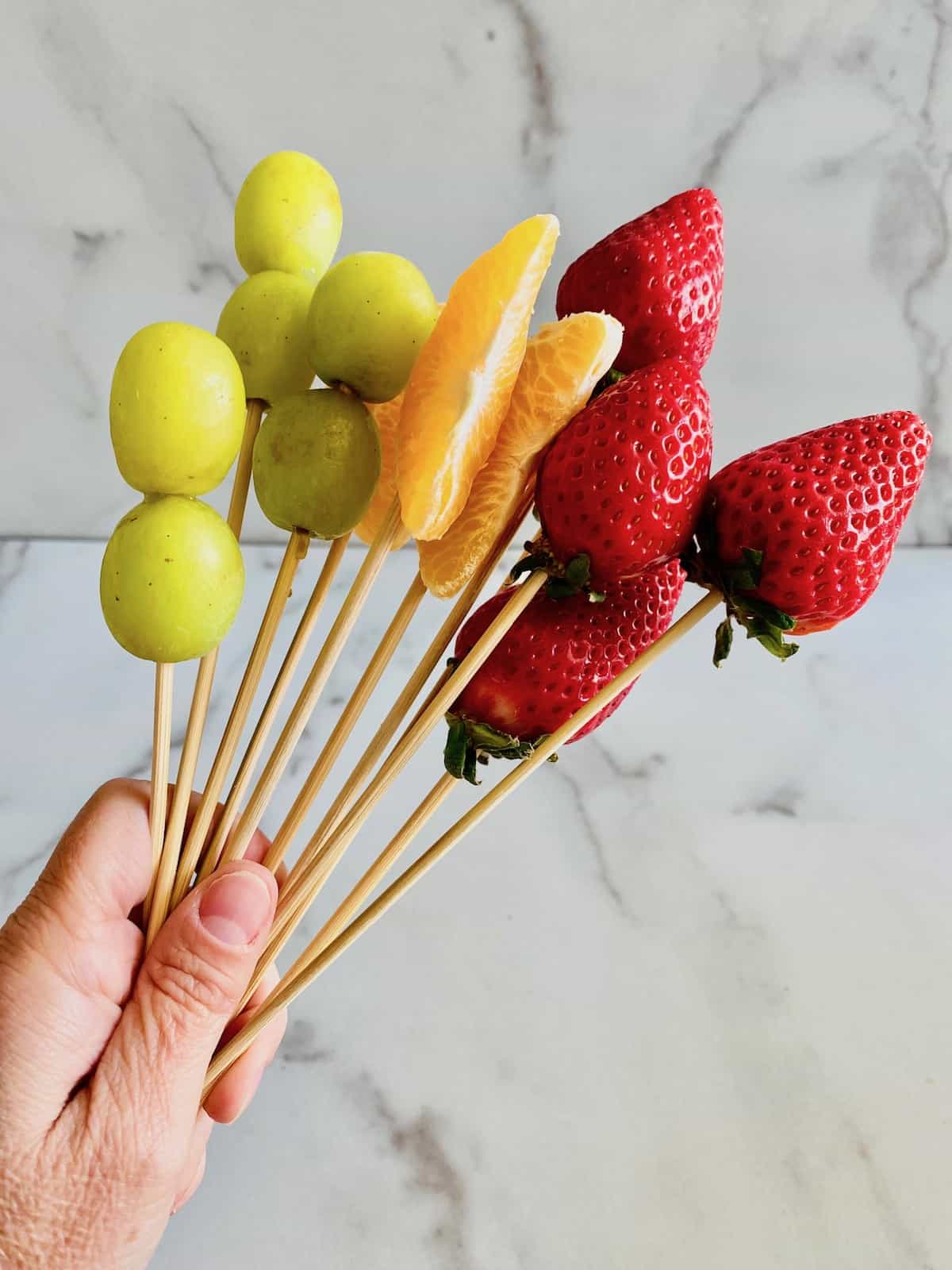
How Much Sugar Water to Make
You want enough sugar water that will coat all the pieces of fruit. It is a 2:1 ratio of sugar to water. This is not the same as simple syrup which is a 1:1 ratio.
To make the sugar water, use a small saucepan and clip on a candy thermometer. Add the sugar and water, and stir to dissolve. Turn the stove on medium-high heat to bring the mixture to a boil. Stir occasionally as the sugar mixture comes to high heat and begins to bubble and thicken.
Continue to stir the sugar about every minute or so. This helps it not crystallize on the sides of the pot and keeps the heat evenly distributed for the candy thermometer to read it accurately.
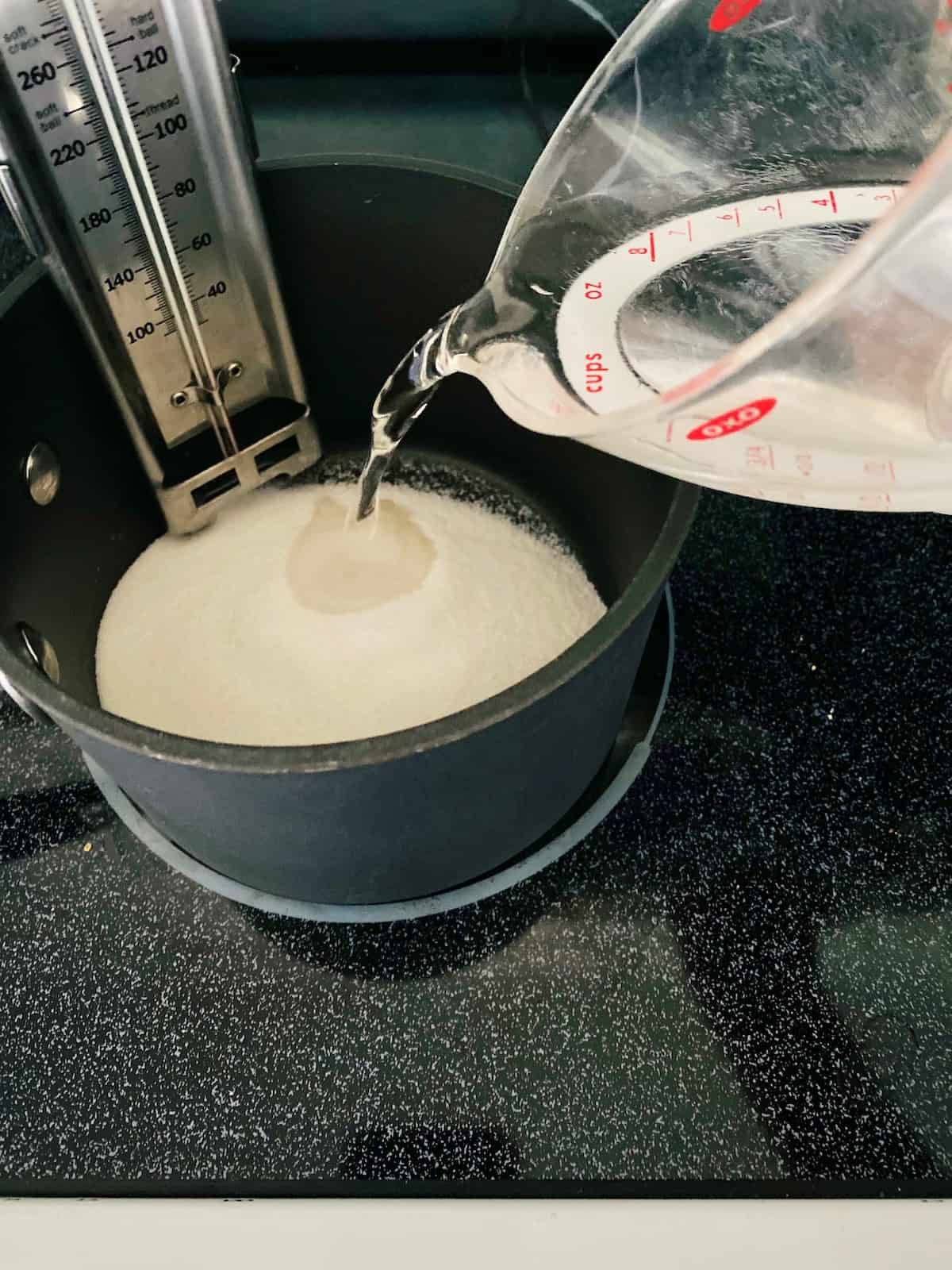
Reaching the Hard Crack Stage for the Sugar Coating
You want to sugar to reach the hard-crack stage. That will be between 295-305°. Many thermometers have a hard crack stage at just above 300. I find if you take this off at 295 or even a bit more - it will be fine.
If you go much over 300° this delicate sugar mix will harden (crystallize) and be overcooked and unusable. Do not leave this unattended and watch it carefully. I DO NOT SUGGEST GOING TO 305°!
As soon as it reaches the right temperature, turn off the heat. Move the pot from the burner to a heat-safe surface. Do not leave it on the stove or it will continue to rise in temperature and be too hot. Too much heat will ruin the melted sugar syrup. You want it to be on the low end of the hard crack stage.
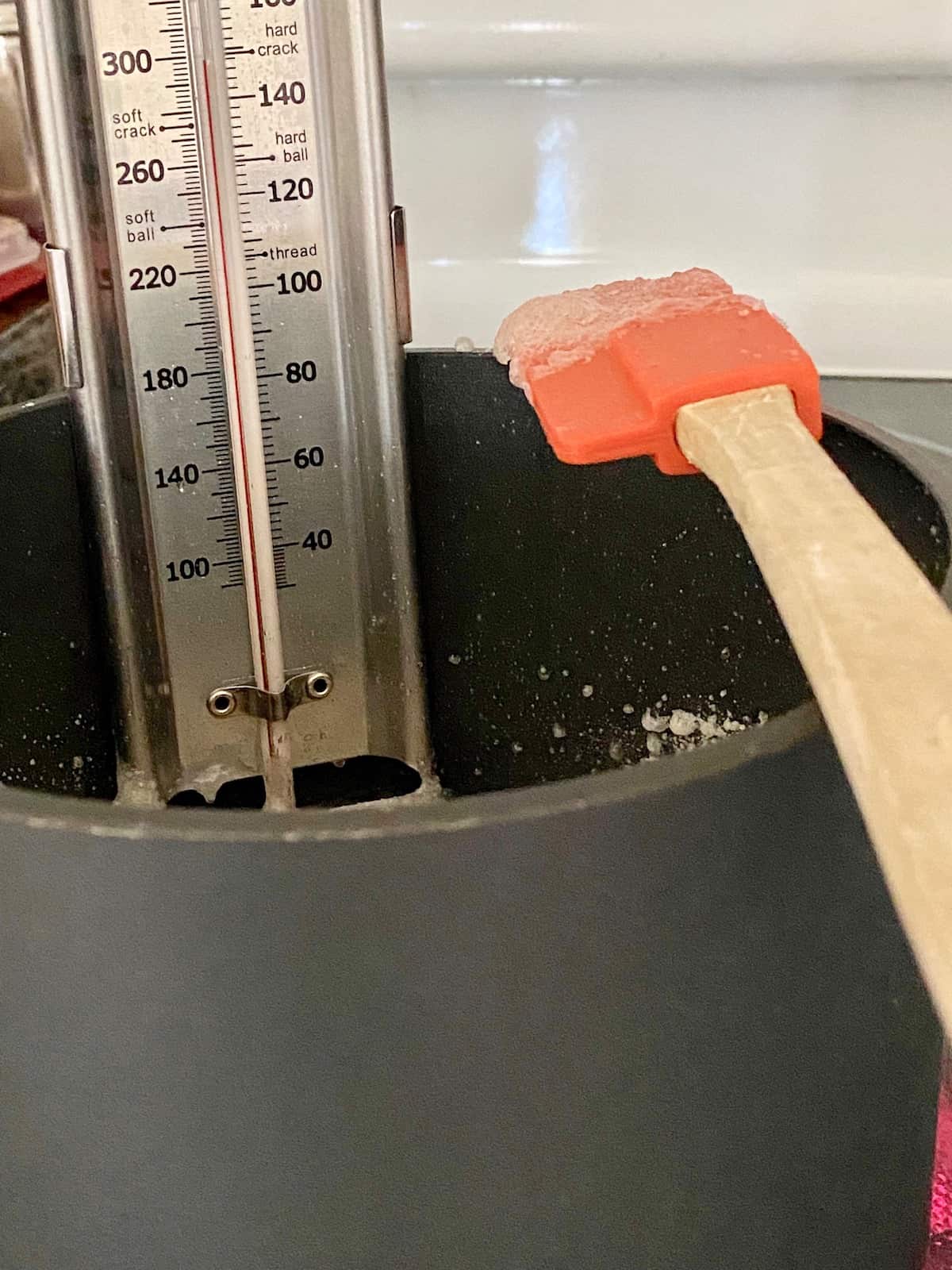
Dipping Fruit to Make Tanghulu
Now that the sugar mixture is ready, you need to work quickly to make the Tanghulu. Tilt the saucepan and dip the fruit into the sugar mixture. Rotate the fruit in the liquid to coat all sides.
Once each piece is completely coated, let the excess drip back into the pot. Next, place each syrup-dipped fruit skewer on the parchment paper. Repeat steps to dip, roll, and set aside.
Hint: Work quickly so the sugar does not cool too much (it will start to crystallize). You can dip 2 at a time if you have extra helpers. Tanghulu is a fun recipe to make with kids, friends, and family so get a few people involved.
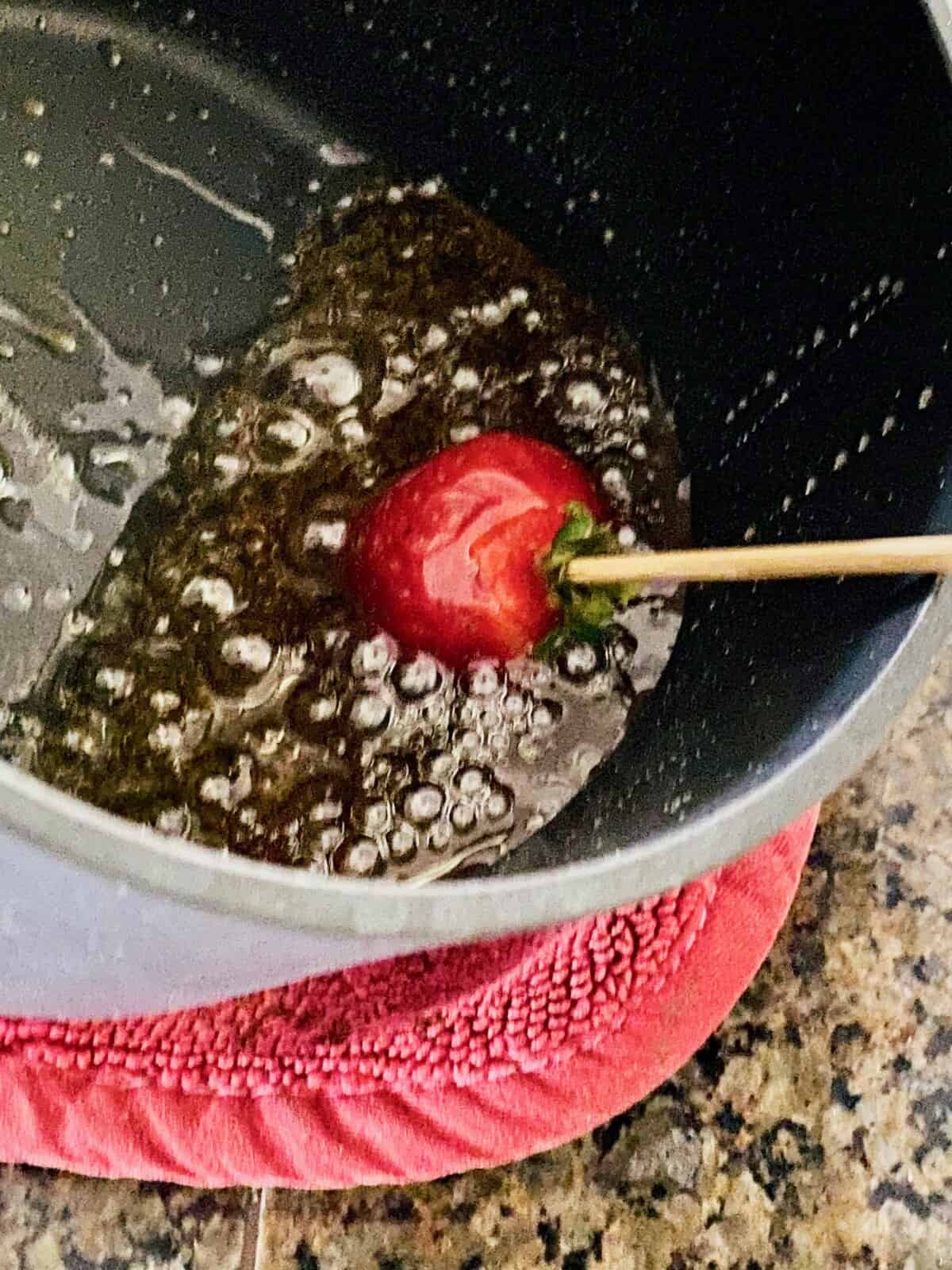
Once all the fruit is coated, let them set up until the candy-coating is hard. If you tap on the Tanghulu lightly, it should be firm and sound like a tap or knock on it. The outer candy shell will be shiny, clear, and solid, as seen below.
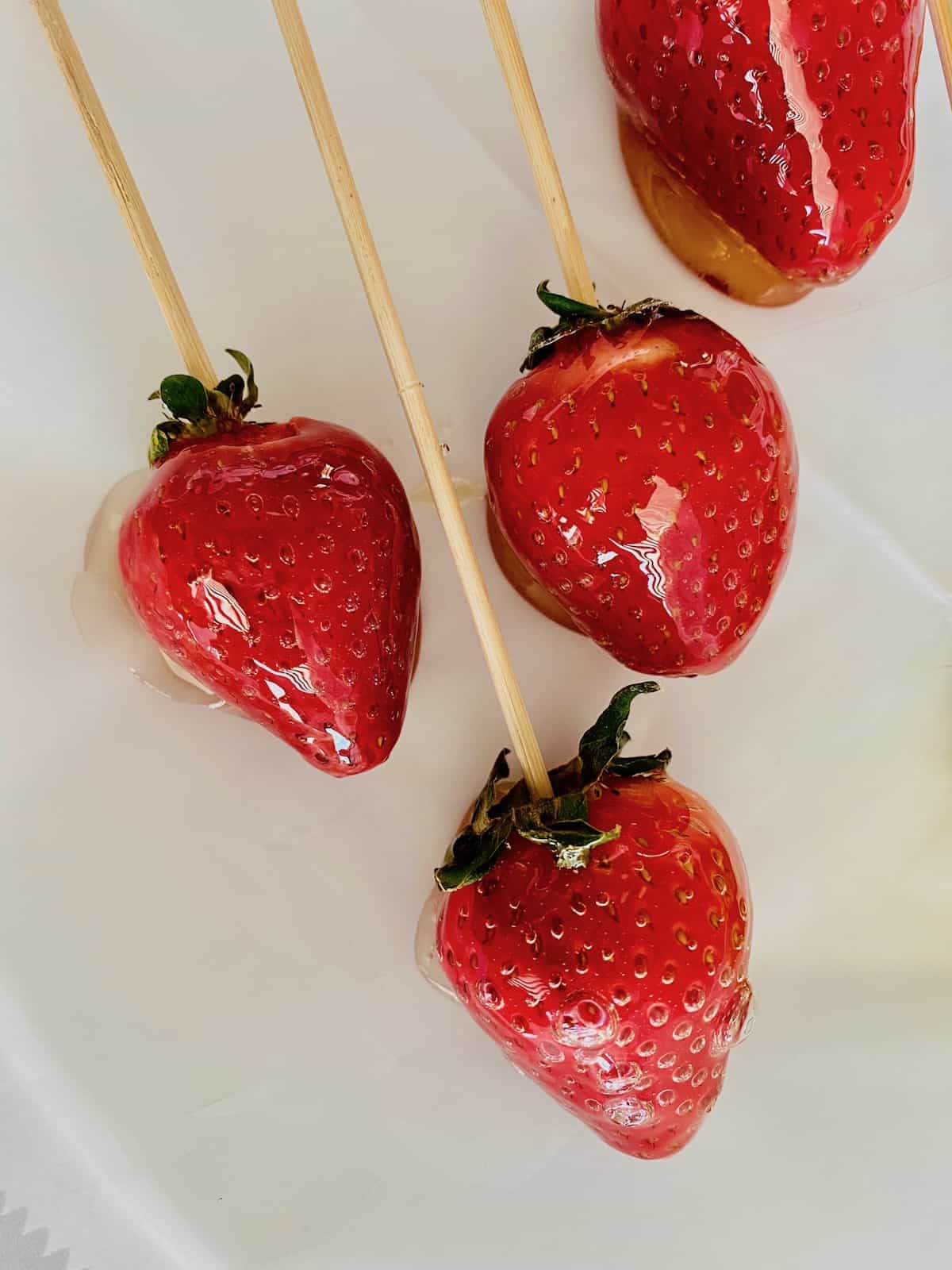
Enjoy homemade tanghulu immediately! The fruit will be sweet, sour, juicy, or crunchy based on whichever fresh fruits you used in this recipe. The sugar shell will crack as you bite it and be crunchy and sweet.
The orange slices will be juicy with a burst of orange juice combined with the hard outer sugar shell for an exciting combination. First, you get the crunch as you bite into the hardened sugar coating and then a pop of fresh citrus juice. I will be honest, this is my favorite of the three, and 2 of my kids agreed.
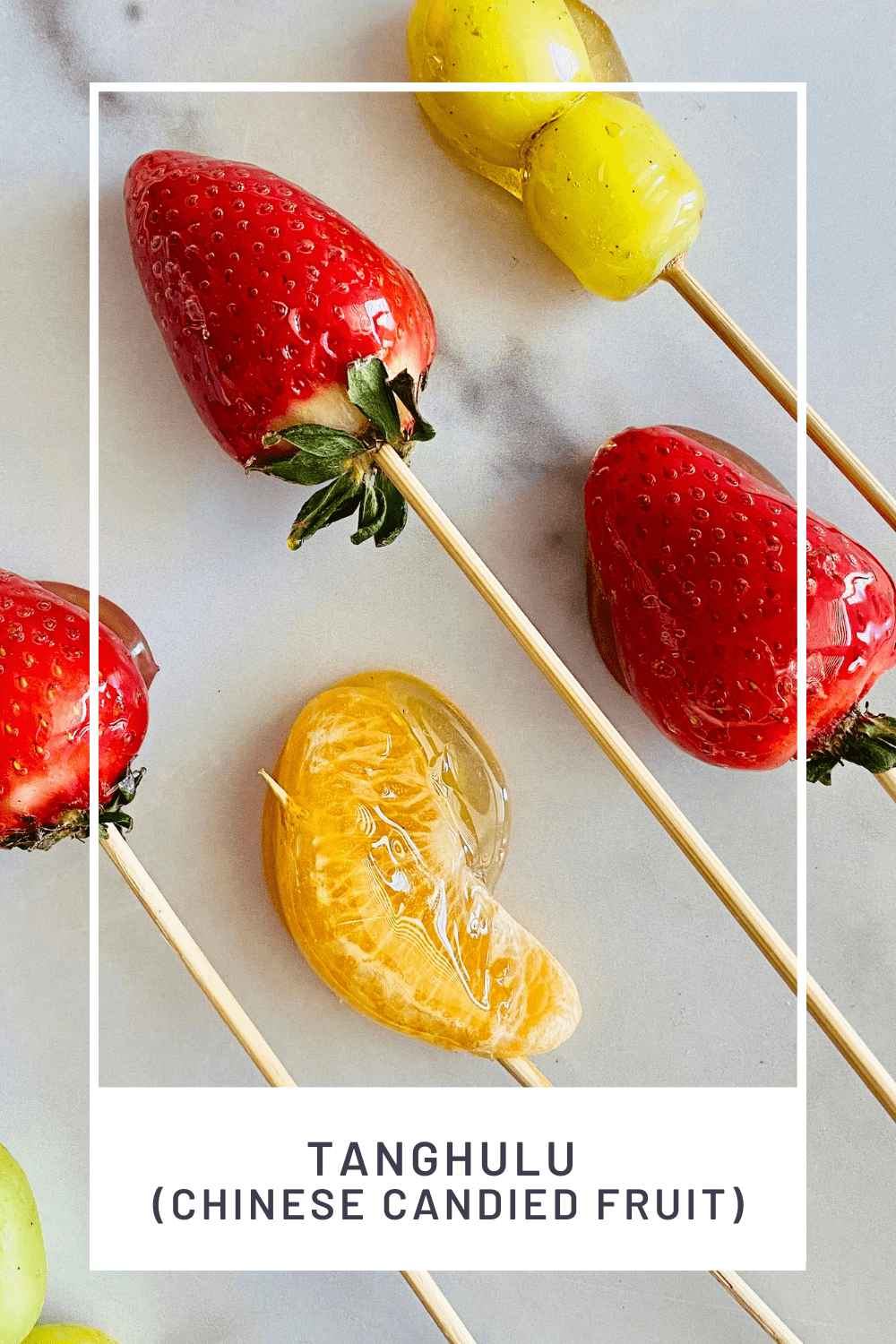
How to Make Tangulu without a Thermometer?
You can make this recipe easily even if you do not have a candy thermometer. You can still make the sugar syrup and bring it to a hard crack stage without a thermometer to read the temperature for you.
So I bet you are wondering how can you tell when it is at a hard crack stage if I don't have a candy thermometer. It is easy to test for the hard crack stage just by using a small clear bowl or glass with cold water in it. Cook the syrup as described below, and once it has been in a rolling bubble for about 5 minutes, start testing a drop at a time.
Add a drop of hot syrup into the cold water, then remove the candy from the water and attempt to bend it. If your syrup has reached the hard-crack stage, it will form drops or strands.
Next, grab the drops or strands and try and bend them. If they break and bend a lot, it is brittle and at the hard crack stage, you want. If it just bends a bit and is soft or almost chewy, continue going and check again in another minute.

Why is My Tanghulu Sticky?
For troubleshooting what went wrong here are some common things that may happen when making this recipe. Tanghulu is a crunchy sweet fruit treat and should not stick to your teeth.
It is a quick and easy way to make tanghulu but still, something may go wrong. Thankfully you can try again and not waste too many ingredients in the process.
- Sticky Tanghulu - this is a result of not getting the sugar mixture hot enough and boiled long enough. It did not reach the hard crack stage. Make sure your thermometer is accurate or you did the cold water test for a brittle drop of sugar (see above).
- Bubbles in my Tanghulu - you may get tiny bubbles in the clear candy coating as you dip and coat the skewered fruit. That is ok but it may not look as clear and lovely as you had hoped. To try and cut down on the bubbles forming, stir the sugar mixture once you take it off the heat. The bubbles will stop once done cooking and it helps minimize those left in the pan as you tilt, dip, & roll the fruit pieces.
- Tanghulu Candy Coating is Not Hard - this can be a result of 1 of 2 things. Either again the hard crack stage was not reached. Make sure you cook the sugar syrup long enough during the boiling to reach 295°-300°. A warm or humid room may cause this too. That will make it harder for the candy shell to set.
Equipment Recommendations
This recipe requires long bamboo skewers, parchment paper, a medium-sized saucepan, and a candy thermometer. If you do not have a candy thermometer, see my instructions above on how to test for the hard crack stage without one.
Here are my recommendations for what you will need to have to make this recipe.
The Short Order Cook is a participant in the Amazon Services LLC Associates Program. As an Amazon Associate, I earn from qualifying purchases. If you click on a link and make a purchase, I may earn a small commission on the sale at no additional cost to you. This helps with the costs of running the blog. Thank you!
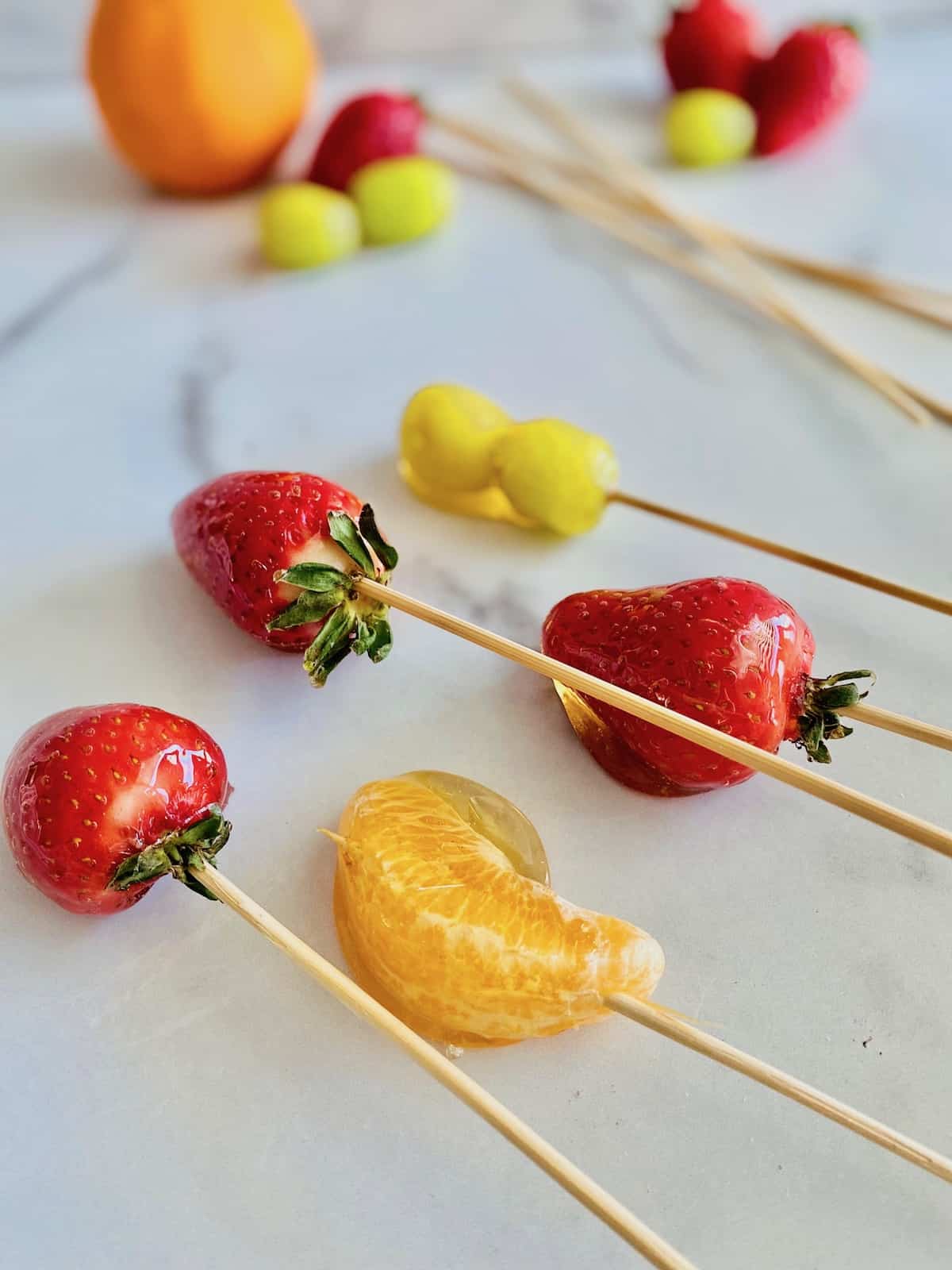
Storage
You do not want to store or make tanghulu ahead of time. As it sits, the juices from the fruit will start to break down the hard candy shell. When this happens it will fill with liquid and ooze out the coating making a soggy mess. The classic crunch will be gone.
Top tip
It is best to make this right before you wish to enjoy tanghulu. This recipe is best eaten immediately. It will harden almost immediately when you make it. Therefore, it is ready to eat in just a minute.
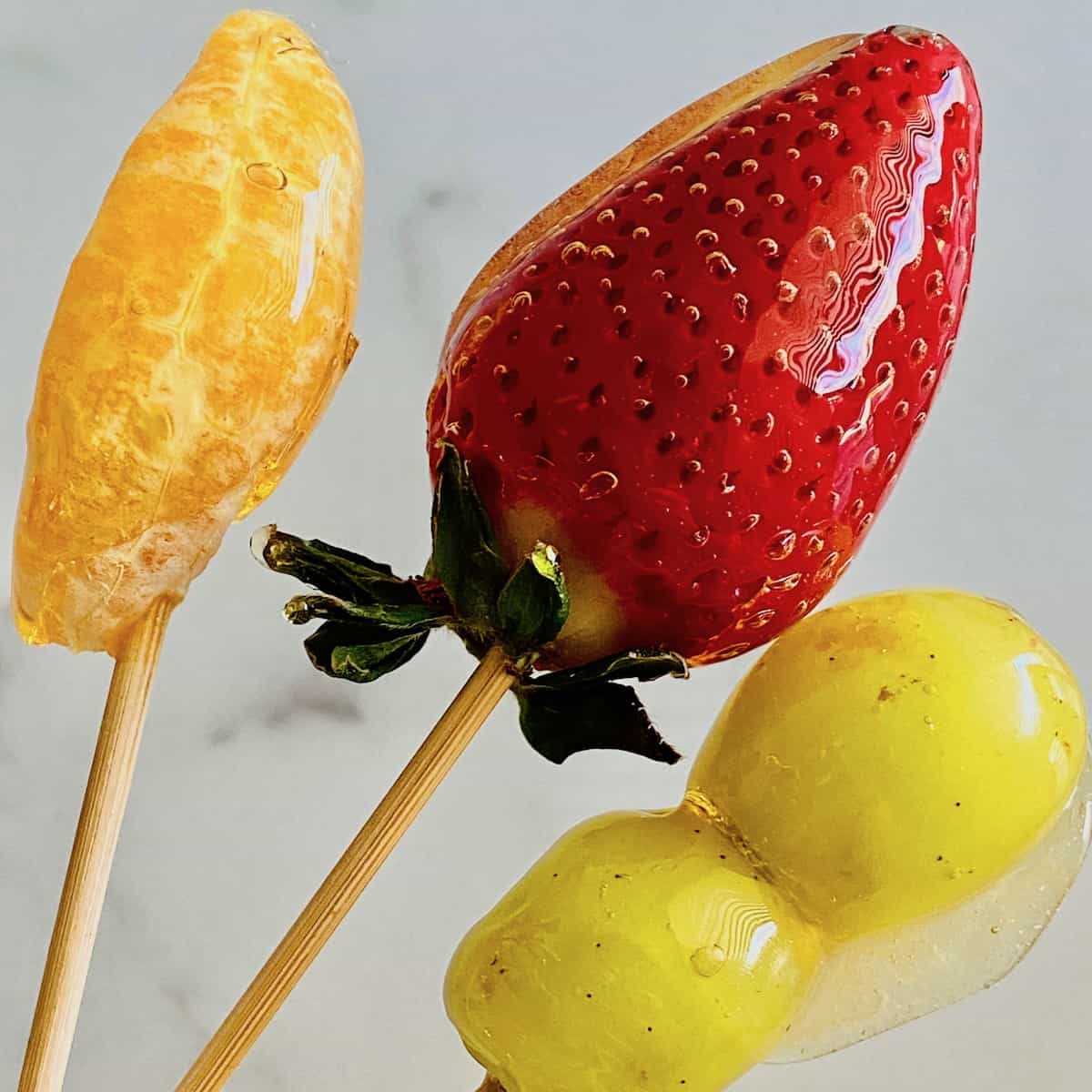
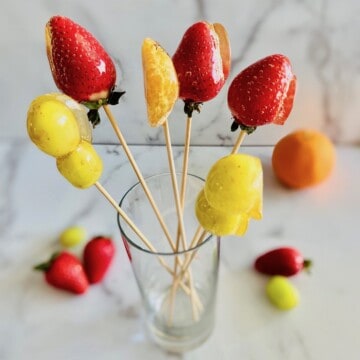
How to Make Tanghulu (Chinese Candied Fruit)
Equipment
- Candy Thermometer
- Parchment Paper
- 12 bamboo skewers
Ingredients
- 1 whole orange peeled and segmented
- 4 large strawberries stem on or off, your decision
- 8 large seedless grapes
- 1 cup granulated sugar
- ½ cup water
Instructions
- Wash and thoroughly dry all the fruit pieces.
- Prep the fruit by pushing a bamboo skewer through each piece so the fruit is now on the very tip of the stick. I suggest one strawberry or orange segment per stick or 2 grapes per stick. Set aside.
- Prep a large platter or baking sheet with parchment paper. You will need this to place the dipped fruit on to set (but not stick) for a few minutes.
- To a small or medium-sized saucepan clip on a candy thermometer. Add the sugar and water. Stir to dissolve. Turn the stove on medium-high heat to bring the mixture to a boil.
- Over the next 5-10 minutes watch the sugar mixture carefully. Stir occasionally as the sugar mixture comes to high heat and begins to bubble and thicken.
- You want to sugar to reach the hard-crack stage. That will be between 295-305°. Many thermometers have a hard crack stage at just above 300. I find if you take this off at 295 or even a bit more - it will be fine. If you go over 300° this delicate sugar mix will crystallize so do not leave this unattended and watch it. You for sure should not go to 305!
- As soon as it reaches the right temperature, turn off the heat. Move the pot from the burner to a heat-safe surface.
- Now it is time to DIP & ROLL the fresh skewers. Tilt the saucepan and dip the fruit into the sugar mixture. Rotate the fruit in the liquid to coat all sides. Once coated place on the parchment paper.
- Work QUICKLY so the sugar does not cool too much (it will start to crystallize) , dip, roll, and set aside on the parchment paper.
- Once all the fruit is coated, let them set up so the candy-coating is hard. If you tap on the fruit lightly, it should be firm and sound like a tap or knock on it.
- ENJOY IMMEDIATELY!

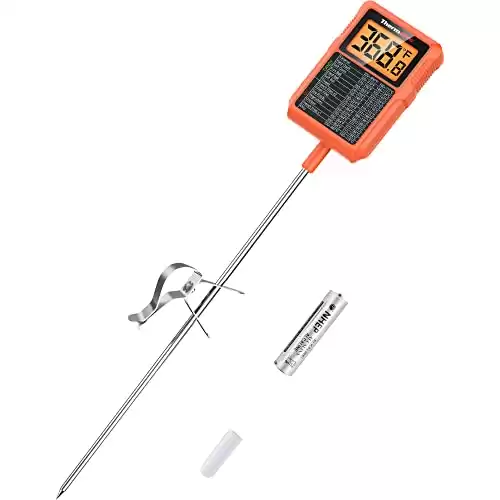
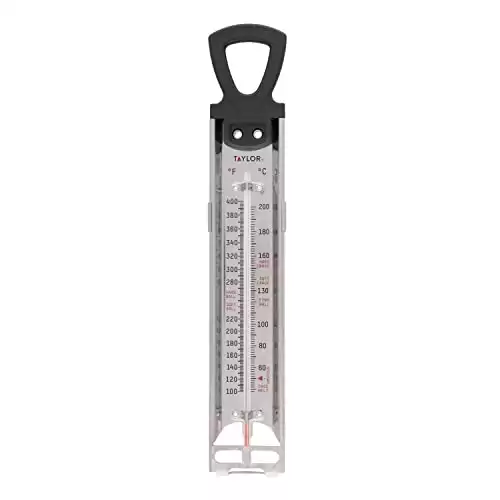
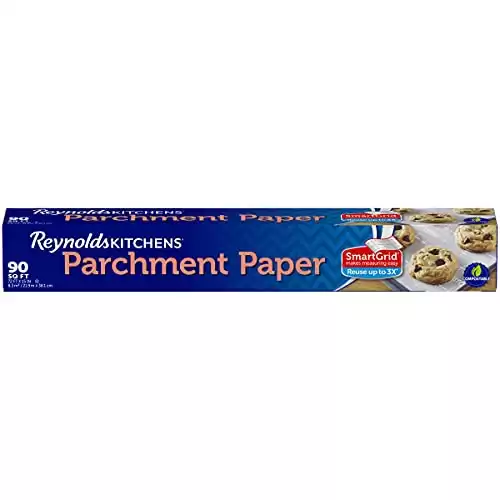
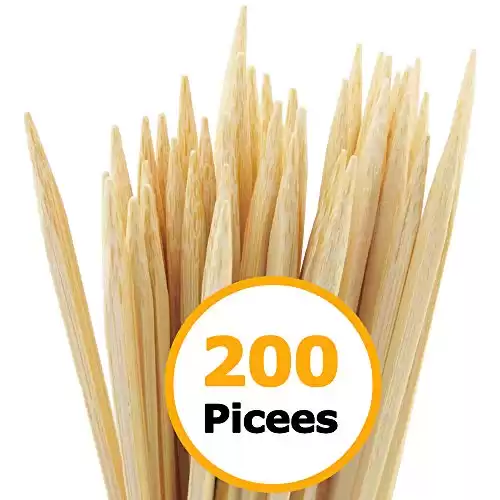
Leave a Reply